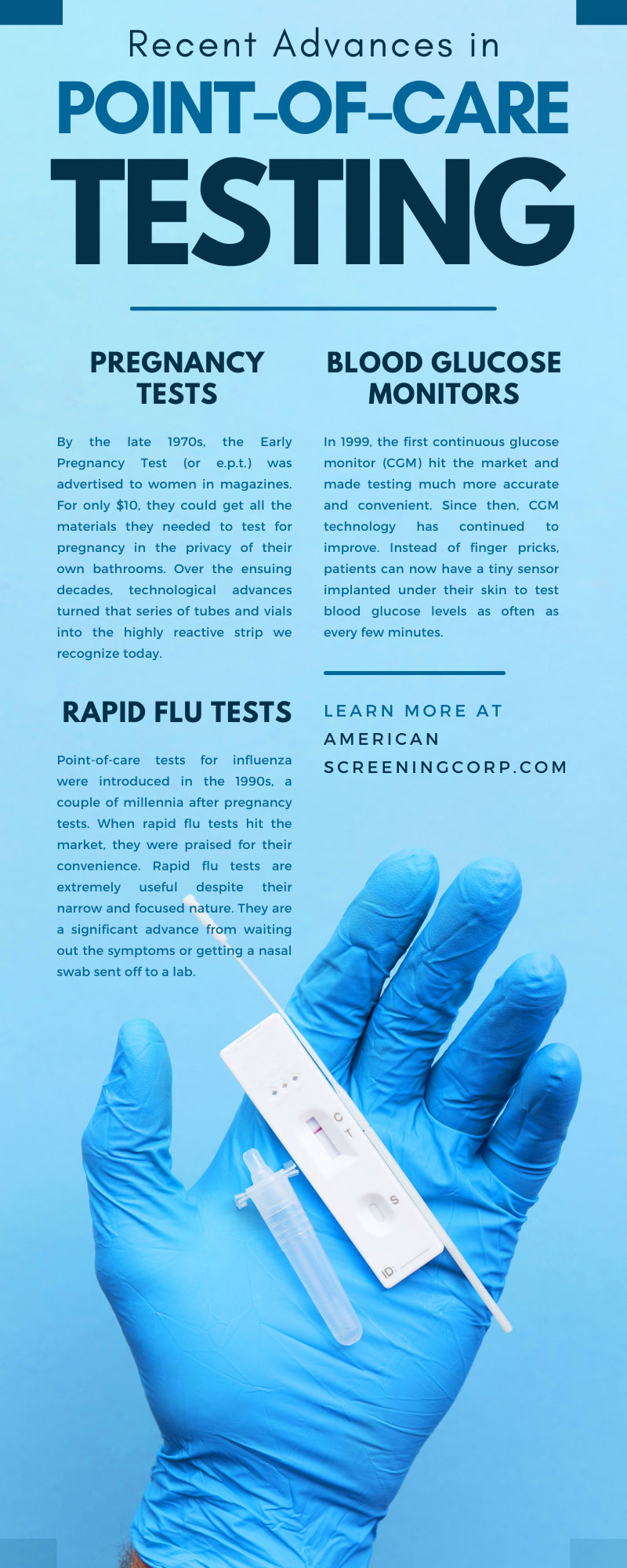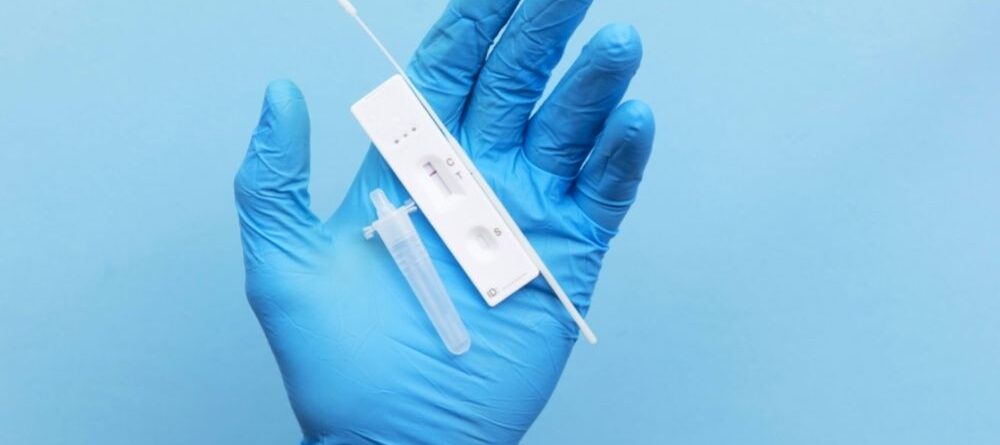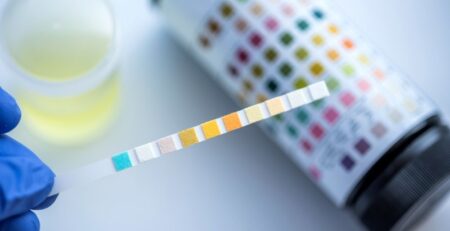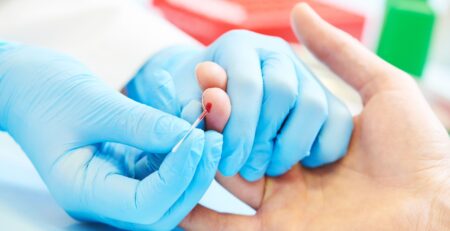Recent Advances in Point-of-Care Testing
What is a point-of-care test? Simply put, it is a medical test that gives you answers within minutes. They are also known as rapid tests or bedside tests. The most popular types of point-of-care tests are home pregnancy tests and blood glucose monitors, but others can test for diseases like the flu. In the 1950s, as more and more industries turned to automation, laboratories were no different. It became easy for doctors to send samples off to the lab and expect results in a few days or weeks. But sometimes, you need answers as soon as possible. American Screening can help you get those answers!
Rapid test results have grown especially crucial over the last year with the emergence of the novel coronavirus. American Screening offers rapid tests for the SARS-CoV-2 antigen in addition to multiple other point-of-care tests. The question weighing on everyone’s mind, though, is: “How accurate are they?”
False results are less common with all the recent advances in point-of-care testing. Let’s look at how the rapid testing process has grown more accurate in various applications over the years.
Pregnancy Tests
Since the days of ancient Egypt, humankind has known that there’s something in human urine that can indicate pregnancy. The process, circa 1350 BC, involved the possibly pregnant person urinating on wheat and barley seeds. If the seeds sprouted and grew, it indicated a positive result. In 1963, scientists tested this theory and found that the basic process worked about 70 percent of the time! They suspected that elevated estrogen levels in a pregnant person’s urine helped the plants grow.
Throughout the centuries, doctors have turned to urine to detect the possibility of pregnancy, even when they weren’t sure what they were looking for. By the 19th century, doctors were getting closer as they detected chemicals (which physiologist Ernest Starling dubbed “hormones”) in the human body that helped it function. Still, their best indicator of pregnancy was to monitor the person’s symptoms (especially morning sickness) and have regular checkups with their doctor.
But once the medical community knew about hormones, the progression and increased reliability of point-of-care testing products grew rapidly. Hormone research exploded during the first half of the 20th century, and testing for possible pregnancy was aided with the discovery of a crucial hormone. Human chorionic gonadotropin (hCG), when found in high concentrations in human urine, is a reliable indicator of pregnancy. Once doctors knew how to test for it specifically, they grew more confident in their testing methods. By the late 1970s, the Early Pregnancy Test (or e.p.t.) was advertised to women in magazines. For only $10, they could get all the materials they needed to test for pregnancy in the privacy of their own bathrooms. It was a little complicated, involving vials and test tubes and medicine droppers, but results were guaranteed within two hours.
Over the ensuing decades, technological advances turned that series of tubes and vials into the highly reactive strip we recognize today. In 2003, many companies that produced pregnancy tests made a slight but crucial change to their design. Instead of a plus or minus sign that could be easy to misread, potential results read either “Pregnant” or “Not Pregnant.”
Rapid Flu Tests
Long before rapid tests were available, people tested for the flu by monitoring their symptoms. This method was inaccurate much of the time and did not account for different strains of influenza. In centuries past, people often died of some strain of the flu, but the similarity in symptoms made it hard for doctors (and coroners) to tell which strain it was.
In the 20th century, alongside the boom of laboratory testing, nasal swabs became the norm for flu testing. Some swabs are more invasive than others; the nasopharyngeal swab goes all the way past your nostrils into your sinuses. (This type of swab may be familiar to you, as it is used in rapid COVID tests!)
Point-of-care tests for influenza were introduced in the 1990s, a couple of millennia after pregnancy tests. When rapid flu tests hit the market, they were praised for their convenience. However, the rapid flu test is an immunoassay—a highly sensitive point-of-care testing product that looks for very specific molecules. Due to their narrow field of testing, false results on rapid flu tests are more common than on other rapid tests. Medical professionals were less than satisfied with rapid testing during the 2009 outbreak of the H1N1 flu, colloquially known as the swine flu.
Rapid flu tests are extremely useful despite their narrow and focused nature. They are a significant advance from waiting out the symptoms or getting a nasal swab sent off to a lab. When used to test larger populations, rapid flu tests are key in detecting infection in large numbers of people and can identify outbreaks quickly.
Blood Glucose Monitors
Starting in the 1800s, medical professionals looked to urine to identify a diabetic patient’s blood sugar. In 1908, the process got a lot quicker when chemist Stanley Rossiter Benedict created a copper reagent to detect glucose. The patient’s urine was mixed with what is now called Benedict’s solution, a clear blue liquid, and heated. If the liquid turned a rusty orange color, it indicated excess glucose. It was a finicky and lengthy process, boasting only limited accuracy.
In the late 1930s and early 1940s, scientists at Miles Laboratories tinkered with the process and made it even easier. Now the altered Benedict’s solution came in tablet form and went on the market under the name Clinitest. With further alterations, designed to remove the need to clean vials and droppers, Miles Laboratories turned that tablet into a little strip they called the Clinistix. It was the first commercially available dip-and-read glucose test. In the years that followed, scientists improved on this little strip more and more. They added reagents to detect the presence of ketones, proteins, and nitrites.
Urine, however, isn’t the most reliable indicator of glucose levels—blood is. By 1965, scientists had used the same strip technology and reagents to test blood. The first portable blood glucose monitor was clunky and required a fairly large drop of blood to produce results. Motivated by the desire for convenience, laboratories honed those test strips to require smaller blood samples.
In 1999, the first continuous glucose monitor (CGM) hit the market and made testing much more accurate and convenient. Since then, CGM technology has continued to improve. Instead of finger pricks, patients can now have a tiny sensor implanted under their skin to test blood glucose levels as often as every few minutes.
Different methods of point-of-care testing have improved over the centuries as the need for immediate test results increases. From heating up urine to instant reagent tests, medicine has come a long way in providing quick answers. These recent advances in point-of-care testing have saved lives—and could save yours!

















